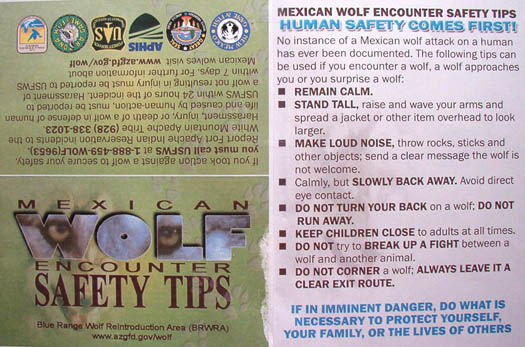WOLVES
AND HUMANS
Danger posed by habituated wolves
In 2002, Fremont County (Wyoming) officials declared gray
wolves and grizzly bears “unacceptable species,” citing
the danger to human health and safety as a major concern.
Neighboring counties soon followed Fremont’s lead.
While the threat to human safety posed by grizzly bears
is evident, what has been the subject of little discussion
is the possible danger posed by wolves. This issue was recently
addressed by the Montana Department of Fish, Wildlife and
Parks as the agency prepared its statewide wolf management
plan.
“ Public safety is an important consideration because
species such as the gray wolf, mountain lion, black or grizzly
bear are capable of injuring or potentially killing a person,” according
to Montana’s wolf conservation and management plan.
A few examples were provided. The document stated: “In
Canada’s Algonquin Provincial Park, four different
wolves progressively lost their fear of humans, resulting
in five separate incidents over the last 11 years. These
four wolves, though previously nonaggressive, eventually
bit humans. Two incidents of wolf aggression towards people
were serious and required stitches.
“ Each of the wolves was accustomed to humans and
had been frequenting campgrounds, running off with backpacks,
human food and other camping items over a period of months,” according
to the document. “People interacted with these wolves
at very close range until the wolf became too bold. Park
managers removed the four wolves.
“ Some wolves in Denali National Park in Alaska have
grown increasingly tolerant of close proximity to humans
in and around campsites, although no injuries have been reported.
“ One incident on Vargas Island, British Columbia
in which a wolf bit a camper paralleled the incidents in
Algonquin Provincial Park. Park managers removed two wolves
that had been loitering near camping areas. One recent incident
in Icy Bay near Anchorage, Alaska left a young boy with several
stitches after a wolf bite. This wolf was also removed.
“ It appears that most wolf-human encounters were
not precipitated by the wolf perceiving the human as prey
because of how the wolves behaved, the presence of domestic
dogs, or the sequence of events,” according to the
Montana document. This is in stark contrast to mountain lion
incidents, in which it appears lions have perceived humans
as prey; or in bear incidents in which bears attack after
surprise encounters with humans, or apparently in defense
of cubs or food.
“ For wolves, a loss of fear seems to be a common
thread running through all North American wolf incidents
resulting in human injury,” the plan stated.
“ It appears that wolves can habituate to humans or
human activities as readily as bears or mountain lions,” the
document stated. “Whether or not this degree of familiarity
translates to a threat to human safety may hinge on prompt
management response by the appropriate authorities.
“ It appears that habituation in wolves may not require
a consistent pattern of food conditioning as seems the case
for bears. Wolves may increase their tolerance for the close
proximity of people through repeated, long-term social interaction
with people and ‘being rewarded’ in some fashion,
whether food or otherwise.”
Interestingly, most cases of wolves inflicting injuries on humans occurred
in parks or preserves where wolves were legally protected. That’s
the cause of concern regarding recent incidents in Yellowstone National
Park.
An early March 2003, Bozeman Chronicle article by Scott
McMillion reported that wolves in Yellowstone National Park “have
become increasingly bold around people and at least one pair
might have scavenged a handout from a lawbreaking traveler
this week.”
Park service officials received reports that Yellowstone
wolves approached cars containing people, peering in the
windows. Wolves also walked close to people busy ‘wolf
watching,’ and such encounters were reportedly becoming
more common.
The park service decided to take action against wolves
appearing too bold towards humans. The U.S. Fish and Wildlife
Service authorized the agency to use “less-than-lethal
munitions (rubber bullets)” in attempt to aversively
condition the animals into maintaining their distance.
_________________________________________________
Wolf Attacks in Alaska and Canada
Montana Fish, Wildlife & Parks, Dec.
1, 2006
People in Alaska have been having harrowing encounters with wolves in
recent years. According to the Fairbanks Daily News-Miner, a wolf chased
a bicyclist last December, gaining on the man as they traveled down the
Dalton Highway until a trucker going by swerved and ran over the wolf,
not stopping to receive his thank you from the cyclist.
A week earlier and 35 miles to the north, a wolf chased
down and bit a woman who finally escaped, with several bites
to her legs, by seeking refuge in a porta-potty. This wolf
was killed by wildlife officials and tested negative for
rabies. The wolf was believed to have been involved in two
other human conflicts, including harassing about 10 tourists
at a bus stop, and a second incident of chasing a motorcycle.
__________________________________________
North country encounters
The most comprehensive work published about wolf conflicts with humans
in the north country is Mark McNay’s “A case history of
wolf-human encounters in Alaska and Canada.” McNay provides details
of 80 cases, including 39 cases involving aggression among healthy
wolves, 12 involving suspected diseased wolves, and 29 cases involving
fearless behavior from non-aggressive animals. Aggressive, nonrabid
wolves bit people in 16 cases.
Read the McNay report at the link below:
 2002: A
Case History of Wolf-Human Encounters in Alaska and Canada (By
Mark E. McNay) Alaska Department of Fish & Game,
Wildlife Technical Bulletin #13, 2002 (52-page, 2007K
PDF) 2002: A
Case History of Wolf-Human Encounters in Alaska and Canada (By
Mark E. McNay) Alaska Department of Fish & Game,
Wildlife Technical Bulletin #13, 2002 (52-page, 2007K
PDF)
__________________________________________
Mexican Wolf Safety
Although the U.S. Fish and Wildlife Service has
been insistent that a Mexican wolf hanging out on a New Mexico
ranch isn’t a threat to humans, check out the propaganda
the agency helped to develop about human safety around Mexican
wolves. Read the brochure here (click for larger
image).

__________________________________________
Hundreds of years of history
No library about wolf attacks on humans would be complete without the
European NINA report that examined wolf attacks on humans around the
world, focusing on the last few hundred years.
The report concluded “there appears to be no doubt
that wolves have on rare occasssions attacked and killed
people. We identified three types of wolf attack, (1) attacks
by rabid wolves, (2) predatory attacks where wolves appear
to have regarded humans as prey, and (3) defensive attacks
where a wolf has bitten a person in response to being cornered
or provoked.”
Read the complete NINA report here:
Read the complete NINA report at the link below:
 2002: The
Fear of Wolves: A Review of Wolf Attacks on Humans NINA
Report: Large Carnivore Initiative for Europe, Ministry
of the Environment (253K, 65-page, 1259K PDF, January,
2002, Scandanavia) 2002: The
Fear of Wolves: A Review of Wolf Attacks on Humans NINA
Report: Large Carnivore Initiative for Europe, Ministry
of the Environment (253K, 65-page, 1259K PDF, January,
2002, Scandanavia)
|



